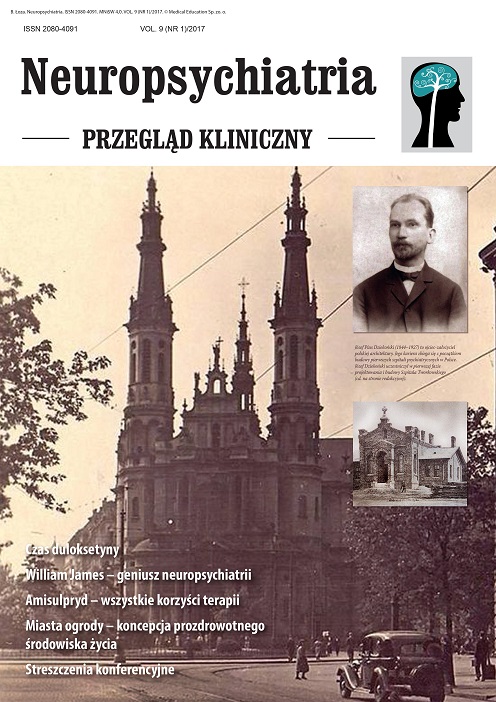Czy warto, żeby psychiatra czytał XIX-wieczny podręcznik psychologii? Artykuł przeglądowy
##plugins.themes.bootstrap3.article.main##
Abstrakt
Teorie Williama Jamesa obecnie przeżywają renesans, a ich zastosowanie dotyczy nie tylko psychologii, ale i psychiatrii. W prezentowanym artykule przedstawiono przykłady aktualności teorii Jamesa dotyczących badań emocji, pamięci i uwagi. W zakresie emocji częstokroć wykpiwana teoria Jamesa–Langego, wskazująca na niezbędność somatycznych przejawów lęku w wytworzeniu i odczuciu emocji, w sposób zadziwiająco trafny tłumaczy wiele stanów patologicznych (życie uczuciowe ludzi z zespołem zamknięcia, z idiopatyczną ortostatyczną hipotonią, patofizjologią napadów lękowych) i fizjologicznych. W zakresie pamięci James zaproponował jej podział (zgodny ze współczesnym) na pierwotną i wtórną. Był też prekursorem badań nad pamięcią operacyjną i jako pierwszy oszacował jej zakres. Ponadto przewidział asocjacyjny charakter pamięci. Jako jeden z pierwszych badał pamięć autobiograficzną i słusznie podejrzewał jej powiązanie z emocjami oraz motywacją. Nawet pogląd o możliwości wytwarzania się „blizn w mózgu” pod wpływem stresu jest, w świetle współczesnej wiedzy o atrofii niektórych struktur (zwłaszcza hipokampu) po przeżyciu urazu psychicznego, niemalże proroczy. Zaproponowany przez Jamesa podział uwagi na mimowolną (dół–góra) i wolicjonalną (góra–dół) stał się paradygmatem współczesnych badań nad mózgiem, a jego zakres sięga nawet najnowszych koncepcji schizofrenii. Wobec trafności i dalekosiężnych skutków częstokroć prostych spostrzeżeń Jamesa jego dorobek naukowy zasługuje na szersze rozpowszechnienie wśród psychiatrów, zwłaszcza w Polsce, gdzie jego znajomość pozostaje nikła.
##plugins.themes.bootstrap3.article.details##

Utwór dostępny jest na licencji Creative Commons Uznanie autorstwa – Użycie niekomercyjne – Bez utworów zależnych 4.0 Międzynarodowe.
Copyright: © Medical Education sp. z o.o. License allowing third parties to copy and redistribute the material in any medium or format and to remix, transform, and build upon the material, provided the original work is properly cited and states its license.
Address reprint requests to: Medical Education, Marcin Kuźma (marcin.kuzma@mededu.pl)
Bibliografia
2. Freeman H. A century of psychiatry. Mosby-Wolfe Medical Communication, London 1999: 18.
3. James W. Principles of Psychology. A Digireads.com Book, 2010. (wyd. polskie: Psychologia. Wydawnictwo Naukowe PWN, Warszawa 2002).
4. James W. What is an Emotion? Mind 1884; 9: 188-205.
5. Bilikiewicz T. Psychiatria kliniczna. Wyd. 7. PZWL, Warszawa 1988: 149.
6. Kalat W. Biologiczne podstawy psychologii. Wydawnictwo Naukowe PWN, Warszawa 2007: 358-362.
7. Laureys S, Pellas F, Van Eeckhout P et al. The locked-in syndrome: what is it like to be conscious but paralyzed and voiceless? Prog Brain Res 2005; 150: 495-511.
8. Panasiuk J. Zespół zamknięcia w diagnozie i terapii logopedycznej. Logopedia Silesiana 2014; 3: 95-114.
9. Bauby JD. Skafander i motyl. Wyd. 3. Wydawnictwo słowo/obraz terytoria, Gdańsk 2013.
10. Chauhan B, Mathias CJ, Critchley HD. Autonomic contributions to empathy: evidence from patients with primary autonomic failure. Auton Neurosci 2008; 140(1-2): 96-100.
11. Critchley HD, Mathias CJ, Dolan RJ. Neuroanatomical basis for first- and second-order representations of bodily states. Nat Neurosci 2001; 4(2): 207-212.
12. Heims HC, Critchley HD, Dolan R et al. Social and motivational functioning is not critically dependent on feedback of autonomic responses: neuropsychological evidence from patients with pure autonomic failure. Neuropsychologia 2004; 42(14): 1979-1988.
13. Strack F, Martin LL, Stepper S. Inhibiting and facilitating conditions of the human smile: a nonobtrusive test of the facial feedback hypothesis. J Pers Soc Psychol 1988; 54(5): 768-777.
14. Davis JI, Senghas A, Ochsner KN. How Does Facial Feedback Modulate Emotional Experience? J Res Pers 2009; 43(5): 822-829.
15. Dzokoto V, Wallace DS, Peters L, Bentsi-Enchill E. Attention to emotion and non-Western faces: revisiting the facial feedback hypothesis. J Gen Psychol 2014; 141(2): 151-168.
16. Ekman P. Facial expressions of emotion: an old controversy and new findings. Philos Trans R Soc Lond B Biol Sci 1992; 335(1273): 63-69.
17. Levenson RW, Ekman P, Friesen WV. Voluntary facial action generates emotion-specific autonomic nervous system activity. Psychophysiology 1990; 27(4): 363-384.
18. Lehrer J. Proust Was a Neuroscientist. A Mariner Book Houghton Mifflin Company. Boston; New York 2008: 158-168.
19. Atkinson RC, Shiffrin RM. Human memory: a proposed system and its control processes. W: Spence KW, Spence JT. The psychology of learning and motivation. Volume 2. Academic Press, New York 1968: 89-195.
20. Maruszewski T. Pamięć jako podstawowy mechanizm przechowywania doświadczenia. W: Strelau J (ed.). Psychologia. Podręcznik akademicki. Gdańskie Wydawnictwo Psychologiczne, Gdańsk 2004: 137-164.
21. James W. Memory. W: James W. Talks to Teachers on Psychology: And to Students on Some of Life’s Ideals. Henry Holt and Company, New York 1899: 116-143.
22. Wang JX, Rogers LM, Gross EZ et al. Targeted enhancement of cortical-hippocampal brain networks and associative memory. Science 2014; 345(6200): 1054-1057. https://doi.org/10.1126/science.1252900.
23. Karl A, Schaefer M, Malta LS et al. A meta-analysis of structural brain abnormalities in PTSD. Neurosci Biobehav Rev 2006; 30(7): 1004-1031.
24. Conway MA. Memory and the self. J Mem Lang 2005; 53: 594-628.
25. Conway MA, Williams HL. Autobiographical Memory. W: Byrne JH (ed.). Learning and Memory: A Comprehensive Reference. Academic Press 2008: 893-909.
26. Maruszewski T. Funkcja motywacyjno-emocjonalna. W: Maruszewski T. Pamięć autobiograficzna. Gdańskie Wydawnictwo Psychologiczne, Gdańsk 2005: 83-85.
27. Koch C. Neurobiologia na tropie świadomości. Wydawnictwo Uniwersytetu Warszawskiego, Warszawa 2008: 161-181.
28. Dima D, Dietrich DE, Dillo W, Emrich HM. Impaired top-down processes in schizophrenia: a DCM study of ERPs. Neuroimage 2010; 52(3): 824-832.
29. Wichowicz HM, Ciszewski S, Żuk K, Rybak-Korneluk A. Czy iluzja wklęsłej maski rzeczywiście jest testem na schizofrenię? Psychiatr Pol 2016; 50(4): 741-745.
30. Friston KJ, Frith CD. Schizophrenia – a disconnection syndrome. Clin Neurosci 1995; 3: 89-97.
31. Friston K, Brown HR, Siemerkus J, Stephan KE. The dysconnection hypothesis. Schizophr Res 2016; 176: 83-94.
32. James W. Doświadczenie religijne. Wydawnictwo Marek Derewiecki, Kęty 2014 (na podstawie edycji z 1918 r.).
33. Damasio A. Błąd Kartezjusza. Wyd. 2. Dom Wydawniczy Rebis, Poznań 2013: 151.
34. Rybakowski J, Pużyński S, Wciórka J. (red.): Psychiatria T. 1. Wyd. 2. Elsevier Urban & Partner, Wrocław 2010: 43.

